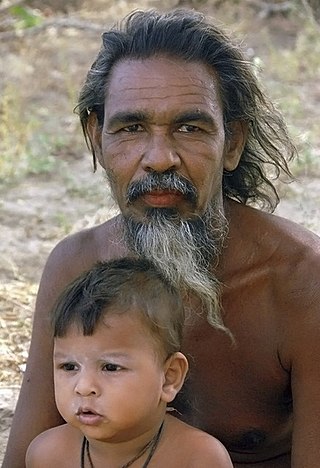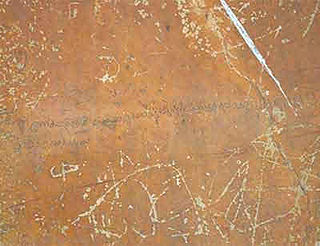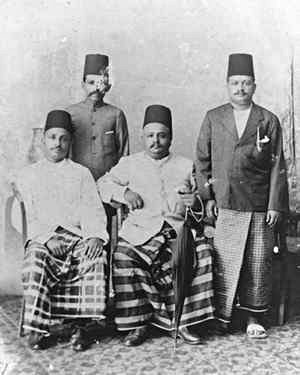Related Research Articles

The Vedda, or Wanniyalaeto, are a minority indigenous group of people in Sri Lanka who, among other sub-communities such as Coast Veddas, Anuradhapura Veddas and Bintenne Veddas, are accorded indigenous status. The Vedda minority in Sri Lanka may become completely assimilated. Most speak Sinhala instead of their indigenous languages, which are nearing extinction. It has been hypothesized that the Vedda were probably the earliest inhabitants of Sri Lanka and have lived on the island since before the arrival of other ethnic groups in India.

Sinhala, sometimes called Sinhalese, is an Indo-Aryan language primarily spoken by the Sinhalese people of Sri Lanka, who make up the largest ethnic group on the island, numbering about 16 million. Sinhala is also spoken as the first language by other ethnic groups in Sri Lanka, totalling about 2 million speakers as of 2001. It is written using the Sinhala script, which is a Brahmic script closely related to the Grantha script of South India.
In addition to its classical and modern literary form, Malay had various regional dialects established after the rise of the Srivijaya empire in Sumatra, Indonesia. Also, Malay spread through interethnic contact and trade across the south East Asia Archipelago as far as the Philippines. That contact resulted in a lingua franca that was called Bazaar Malay or low Malay and in Malay Melayu Pasar. It is generally believed that Bazaar Malay was a pidgin, influenced by contact among Malay, Hokkien, Portuguese, and Dutch traders.
Burgher people, also known simply as Burghers, are a small Eurasian ethnic group in Sri Lanka descended from Portuguese, Dutch, British and other Europeans who settled in Ceylon. The Portuguese and Dutch had held some of the maritime provinces of the island for centuries before the advent of the British Empire. With the establishment of Ceylon as a crown colony at the end of the 18th century, most of those who retained close ties with the Netherlands departed. However, a significant community of Burghers remained and largely adopted the English language. During British rule, they occupied a highly important place in Sri Lankan social and economic life.
Sri Lanka Indo-Portuguese, Ceylonese Portuguese Creole or Sri Lankan Portuguese Creole (SLPC) is a language spoken in Sri Lanka. While the predominant languages of the island are Sinhala and Tamil, the interaction of the Portuguese and the Sri Lankans led to the evolution of a new language, Sri Lanka Portuguese Creole (SLPC), which flourished as a lingua franca on the island for over 350 years (16th to mid-19th centuries). SLPC continues to be spoken by an unknown number of Sri Lankans, estimated to be extremely small.

Hambantota is the main town in Hambantota District, Southern Province, Sri Lanka.
Sri Lankan English (SLE) is the English language as it is used in Sri Lanka, a term dating from 1972. Sri Lankan English is principally categorised as the Standard Variety and the Nonstandard Variety, which is called as "Not Pot English". The classification of SLE as a separate dialect of English is controversial. English in Sri Lanka is spoken by approximately 23.8% of the population, and widely used for official and commercial purposes. Sri Lankan English being the native language of approximately 5,400 people thus challenges Braj Kachru's placement of it in the Outer Circle. Furthermore, it is taught as a compulsory second language in local schools from grade one to thirteen, and Sri Lankans pay special attention on learning English both as children and adults. It is considered even today that access and exposure to English from one's childhood in Sri Lanka is to be born with a silver spoon in one's mouth.

Sri Lankabhimanya Karu Jayasuriya is a Sri Lankan politician. He was the Speaker of the Parliament of Sri Lanka. Previously he was Mayor of Colombo from 1997 to 1999, Minister of Power and Energy from 2001 to 2004, Minister of Public Administration and Home Affairs from 2007 to 2008, and Minister of Buddha Sasana, Public Administration, and Democratic Governance in 2015. He has served as Chairman of the Leadership Council of the United National Party (UNP), as well as Deputy Leader of the UNP. He is a member of parliament representing the Gampaha District since 2001. He had served as Sri Lanka's Ambassador to (Germany). As Speaker of Parliament, he also acts as Chairman of the Constitutional Council.
The Sri Lankan Kaffirs are an ethnic group in Sri Lanka who are partially descended from 16th-century Portuguese traders and Bantu slaves who were brought by them to work as labourers and soldiers to fight against the Sinhala kings. They are very similar to the Zanj-descended populations in Iraq and Kuwait, and are known in Pakistan as Sheedis and in India as Siddis. The Kaffirs spoke a distinctive creole based on Portuguese, and the "Sri Lankan Kaffir language". Their cultural heritage includes the dance styles Kaffringna and Manja and their popular form of dance music Baila.
Hugh L. Nevill was a British civil servant, best known for his scholarship and studies of the culture of Sri Lanka.

Hambantota District is a district in Southern Province, Sri Lanka. It is one of 25 districts of Sri Lanka, the second level administrative division of the country. The district is administered by a District Secretariat headed by a District Secretary appointed by the central government of Sri Lanka.

Kompagngna Veediya also known as Kampong Kertel and Kompanna Veediya, formerly known as Slave Island, is a suburb in Colombo, Sri Lanka, located directly south of the Fort. The suburb contains Beira Lake, a large lake and its esplanade is visited by many for recreation. Company Roads is mostly a commercial area with hotels, shopping centres, street food stalls, and is known for its multicultural, especially Malay heritage.

The Sri Lankan Tamil dialects or Ceylon Tamil or commonly in Tamil language Eelam Tamil are a group of Tamil dialects used in Sri Lanka by its native Tamil speakers that is distinct from the dialects of Tamil spoken in Tamil Nadu. It is broadly categorized into three sub groups: Jaffna Tamil, Batticaloa Tamil, and Negombo Tamil dialects. But there are a number of sub dialects within these broad regional dialects as well. These dialects are also used by ethnic groups other than Tamils and Muslims such as Sinhalese people, Portuguese Burghers and the indigenous Coastal Vedda people.

Sri Lankan Moors are an ethnic minority group in Sri Lanka, comprising 9.3% of the country's total population. Most of them are native speakers of the Tamil language. The majority of Moors who are not native to the North and East also speak Sinhalese as a second language. They are predominantly followers of Islam. The Sri Lankan Muslim community is mostly divided between Sri Lankan Moors, Indian Moors, Sri Lankan Malays and Sri Lankan Bohras. These groups are differentiated by lineage, language, history, culture and traditions.

The main languages spoken in Sri Lanka are Tamil and Sinhala. Several languages are spoken in Sri Lanka within the Indo-Aryan, Dravidian, and Austronesian families. Sri Lanka accords official status to Sinhala and Tamil, with English as a recognised language. The languages spoken on the island nation are deeply influenced by the various languages in India, Europe and Southeast Asia. Arab settlers and the colonial powers of Portugal, the Netherlands and Britain have also influenced the development of modern languages in Sri Lanka. See below for the most-spoken languages of Sri Lanka.
Vedda is an endangered language that is used by the indigenous Vedda people of Sri Lanka. Additionally, communities such as Coast Veddas and Anuradhapura Veddas who do not strictly identify as Veddas also use words from the Vedda language in part for communication during hunting and/or for religious chants, throughout the island.

Sri Lankan Malays are Sri Lankan citizens with full or partial ancestry from the Indonesian Archipelago, Malaysia, or Singapore. In addition, people from Brunei and the Philippines also consider themselves Malays.
The Dutch Burghers are an ethnic group in Sri Lanka, of mixed Dutch, Portuguese Burgher and Sri Lankan descent. However, they are a different community when compared with Portuguese Burghers. Originally an entirely Protestant community, many Burghers today remain Christian but belong to a variety of denominations. The Dutch Burghers of Sri Lanka speak English and the local languages Sinhala and Tamil.

Alamat Langkapuri was a Malay-language fortnightly publication in Jawi script, issued from Colombo, Ceylon. Alamat Lankapuri was first published in June 1869. It was the first Jawi script Malay-language newspaper printed worldwide. The newspaper was printed by lithograph.

Dosi is a traditional Sri Lankan confectionery, similar in nature to fruit preserves or candied fruit. The dish is prepared by boiling segmented fruit in sugar and allowing it to cool in order for the sugar to crystallise on both the surface and the inside of the fruit. Dosi are traditionally served as a snack, during the day or after a meal. It is a dish that is commonly served by Sri Lankan Malays as a part of traditional Eid al-Fitr celebrations, marking the end of Ramadan. It is also popular during weddings, religious festivals and other social functions and celebrations. Variations include the addition of cardamom and/or cinnamon and/or rose essence.
References
- ↑ Sri Lankan Malay at Ethnologue (18th ed., 2015) (subscription required)
- 1 2 3 4 "APiCS Online - Survey chapter: Sri Lankan Malay". apics-online.info. Retrieved 6 October 2018.
- ↑ de Silva Jayasuriya, Shihan (2002). "Sri Lankan Malay: A Unique Creole" (PDF). NUSA: Linguistic Studies of Languages in and Around Indonesia. 50: 43–57.
- 1 2 3 Mahroof, M. M. M. (1992). "Malay Language in Sri Lanka: Socio-mechanics of a Minority Language in Its Historical Setting". Islamic Studies. 31 (4): 463–478. ISSN 0578-8072. JSTOR 20840097.
- ↑ Jack Prentice (2010), "Manado Malay: Product and agent of language change", in Tom Dutton, Darrell T. Tryon (ed.), Language Contact and Change in the Austronesian World, Trends in Linguistics. Studies and Monographs [TiLSM] 77, Berlin–Boston: Walter de Gruyter, pp. 411–442, ISBN 978-3-11-088309-1, OCLC 853258768 , retrieved 19 September 2022
- 1 2 3 4 5 6 Saldin, B. D. K. (27 May 2011). "Converting Sri Lankan Malay into a written language". The Island.
- ↑ Ansaldo, Umberto (2008). Harrison, K. David; Rood, David S.; Dwyer, Arienne (eds.). Sri Lanka Malay revisited: Genesis and classification. Typological Studies in Language 78. Amsterdam: John Benjamins Publishing Company. pp. 13–42. ISBN 978-90-272-2990-8.
- 1 2 Lim, Lisa; Ansaldo, Umberto (2006). "Keeping Kirinda vital: The endangerment-empowerment dilemma in the documentation of Sri Lanka Malay". Language and Communication Working Papers. 1: 51–66.
- ↑ Rassool, Romola (2015). Download citation of Examining responses to perceived 'endangerment' of the Sri Lanka Malay language and (re)-negotiating Sri Lanka Malay identity in a postcolonial context. Third Bremen Conference on Language and Literature in Colonial and Postcolonial Contexts, At Bremen, Germany.
- ↑ Citation error. See inline comment on how to fix it. [ verification needed ]
- ↑ Ansaldo, Umberto (2011). "Sri Lanka Malay and its Lankan adstrates". Typological Studies in Language. 95: 367–382. doi:10.1075/tsl.95.21ans. ISBN 978-90-272-0676-3.